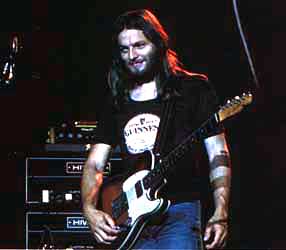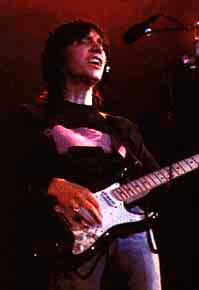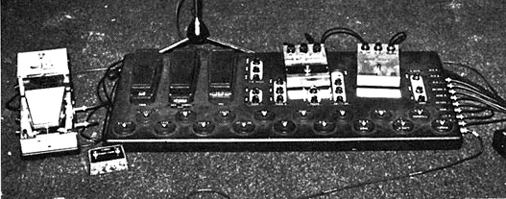|
Animals Live: Gilmour's Traveling Power Station By Richard Mahon
In this column, I'll be examining Pink Floyd guitarist David Gilmour's gear and playing techniques from a musician's point of view. Please feel free to e-mail me with questions and ideas for future articles at RichM66@Compuserve.com if you feel you have an idea that readers of Spare Bricks might find of interest. Past articles are posted here. Gilmour's
primary guitar for the 1977 tour was an early 70s Fender Stratocaster
(black with a black pickguard with white knobs and pickups) with a 1966
Fender Stratocaster neck (rosewood fretboard.) Gilmour used this guitar
from 1974 until the 1977 tour. It underwent many changes through the
years--a DiMarzio pickup was placed in the bridge position. The ground
was re-wired to improve the shielding from noise. The volume and tone
knobs were connected directly to the output jack to cut down on bad
connections. A switch was added to combine the sounds of the bridge
pickup with the neck pickup. To help the guitar stay in tune, the six
screws that hold the tremolo in place were tightened so there would
be no space between the screws and the plate. Four tremolo springs were
used in the back for live performances (only three tremolo springs were
used in the studio.)
A
second guitar, a Fender Telecaster, was used for "Dogs." The guitar
had a humbucking pickup installed in the neck position and the guitar
was always tuned down a whole step (D-G-C-F-A-D from the sixth to the
first string.) This guitar was also used for the 1975 tour when the song was titled "You've Gotta Be Crazy." Gilmour
used his Electric Mistress Flanger with the guitar on a clean setting
to play the opening of "Dogs". The opening was played on an
acoustic guitar on the Animals album. Roger Waters played a Fender Stratocaster (black, with a maple neck) for "Pigs (Three Different Ones)" while backing guitarist Snowy White played bass. The
1977 tour for Animals also brought new technology forward as
Gilmour toured with a Pete Cornish pedal board for the first time. Three
Cry-Baby Sweep Pedals sat on the left side of the board as a tone control,
volume pedal and wah-wah. An earlier version of an Electro-Harmonix
Electric Mistress Flanger can be seen next to an Electro-Harmonix Big
Muff. The photograph also shows an extensive line up of foot switches
- each used to control pedals and combinations of pedals. Other pedals
included an MXR Phase 90, Orange Treble and Bass Booster, Arbiter Fuzz
Face, Noise Gate, and an MXR Digital Delay. A Binson Echorec that Gilmour
had used for many years sat at the top of his amp heads. Another set of three independent output switches was used to send the signal to any of his amps or any combination. The amplifier list included Hi-Watt heads and WEM speaker cabinets.
Pete Cornish created additional pedal boards for second guitarist Snowy White (who used a Gibson Gold Top Les Paul with Hi-Watt and Fender Dual Showman amplifiers) and bassist Roger Waters. Richard Mahon is a staff writer for Spare Bricks |



